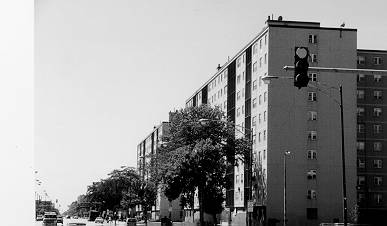I was totally unprepared when I walked into the office of Alex Polikoff, the attorney who oversees the landmark Civil Rights housing case known as the Gautreaux Decree. First, when I pulled out my notes, I found out I had picked up the wrong notebook.
I suddenly couldn’t remember the questions that were so important when I wrote my notes. I pulled out my camera and Polikoff made it clear that he preferred I didn’t take any photographs. I agreed and told him that I already had a photograph of him on file.
Misinformed and mislead was how I felt. I had listened to different sides and stories about the Gautreaux Decree. And not one of those stories painted a picture of Gautreaux quite like Polikoff did. Strange as it may seem, I felt violated. I looked around the room and found not one hole to crawl in. But I faced up to my ignorance, swallowed my pride, shut up and listened.
Polikoff handed me a booklet explaining who Dorothy Gautreaux was. He gave me recent photo-copied articles from the Chicago Tribune about the Chicago Housing Authority and the new breed of subsidy housing that we are faced with, Section 8.
My concern was about Dorothy Gautreaux and the Gautreaux Decree. Dorothy only lived 41 years but she accomplished a great deal within her time frame. Had Ms. Gautreaux not sued the U.S. Department of Housing and Urban Development and CHA, then someone else would have. Her name became the name of the decree but she was one of many who filed the suit in 1966. She died in 1968, long before the suit was finally settled.
Residents’ View on Public Housing
Ms. Gautreaux lived in Altgeld-Murray Homes and she asked the same questions that all public housing residents ask. I can safely say that as Dorothy looked at the public housing stock in the city, she said to herself as I say to myself upon occasion:
“If these complexes had been built in a white neighborhood, would they be more in tune with the times, more configured with the neighborhood and totally geared to aesthetically give one a feeling of pride?”
Nothing is wrong with building houses for the poor in poor neighborhoods. But when you mix poor design with poor material and place it in a poor neighborhood with poor people, you tell me how many people can rise from such rubble.
Ms. Gautreaux knew that if public housing was built in white neighborhoods, the design, structure and grade of material would be number one. Quality stock. Nothing but the best. She knew that it would be built to fit the scope of the community, not making a community fit into its structure, which is what has taken place within our developments.
It is true that public housing was only being constructed in the poorest of African American neighborhoods. The process of choosing which neighborhood received public housing became totally political in Chicago. Aldermen had the final say in where housing was to be placed. Knowing that the majority of aldermen did not live in Black neighborhoods and knowing that they didn’t want Black people in their neighborhoods, it was easy for them to place African Americans in existing African American neighborhoods. And there was never an objection until the target was Lake Shore Drive.
The lakefront has always been considered Chicago’s prime real estate. A few public housing buildings have been placed along Lake Shore Drive but for the most part, it has been preserved for upper-income development.
When the Gautreaux case was first filed, many people in Chicago were concerned that public housing residents would be placed in upper-income neighborhoods. Even the first federal judge appointed to the Gautreaux case, Judge Richard B. Austin, shared this concern. When he was first told about the case, Austin quipped, “Where do you want to put them (CHA residents) – on Lake Shore Drive?”
Polikoff explains
Polikoff, who administers the Gautreaux Decree as the executive director of Business and Professional Persons in the Public Interest, explained the legalities of the Gautreaux Decree concerning HUD and CHA.
Beginning in 1976, after the case went to the U.S. Supreme Court, the U.S. Department of Housing and Urban Development (HUD) was ordered to use its money to place African Americans in non-African American neighborhoods throughout the Chicagoland area, mainly in the suburbs.
CHA, meanwhile, must build scattered site units only in certain areas of the city. The Gautreaux decree, as Polikoff explained it to me, says that CHA can only build housing units in neighborhoods that are more than 30 percent African American if it builds the same number of units in non-African American units in a one-for-one ratio.
This one-for-one housing ratio means that if CHA were to build 71 units in my neighborhood, Darrow Homes on the south lakefront, they would also have to build 71 units in certain areas that are less than 30 percent African American.
Changes have taken place since the ratification of the decree. The original case order was a 3 to 1 housing ratio, meaning that three houses had to be built in predominantly white neighborhoods to every one in a Black neighborhood.
HUD Finally Fulfills Court Order
HUD’s part of the Gautreaux Decree is now over. Started in 1976, the program was run by the Leadership Council of Metropolitan Open Communities to give African American families a chance to live in decent and affordable housing outside of the parameters of public housing.
The Leadership Council Section 8 program was funded by HUD. The families who benefited from the program were moved to homes in mainly white suburbs. Last year in October, the mark of 7,100 families served -the original number sought by this part of the decree – was reached.
HUD is out of the red it has finally fulfilled its obligations to the public housing residents in Chicago.
I know the majority of families who moved to the suburbs through the Leadership Council’s program are happy with their new surroundings. I know they made the best of a bad situation. Their lives are happier now for whatever reason.
But you can’t convince me that they didn’t face discrimination along the way. Is it really necessary to move from the ‘hood to become a productive citizen? The answer is no. No wonder the developments are in such a mess. Somebody told them the only way for them to get ahead in life is to move away. Somebody told them they had to move into another neighborhood and embrace another people.
But I do understand their plight. They want better schools and better homes.
CHA’s turn
Now it’s CHA’s turn to fulfill their duties in constructing housing for its residents. As I was told by Polikoff, CHA failed for many years to build any public housing.
Even though CHA was first ordered to build scattered site units in non-African American neighborhoods in 1969, CHA never actually built any new public housing units. Finally, in 1987, Polikoff went back to court and won an order to allow the Habitat Company, a private development firm, to build scattered site housing. Habitat has built almost 2,000 units since that time.
The Darrow Homes Story
At Darrow Homes, $11 million is being put toward redevelopment on site. Where there once were 480 units in the four Darrow high-rises, now we want to place just 100 houses and duplexes on the same site. Even going through that, Polikoff had total control on deciding our future.
On March 29, 1996, Darrow residents first met with Polikoff about our plan. He rejected it because CHA would not be building at a one-for-one ratio in a non-African American neighborhood.
In the spring of this year, we (the Darrow residents) met with Polikoff again to discuss the construction of the new units. One of the four Darrow buildings had already been torn down and one more was on the chopping block. In the end, all four buildings will be gone.
Polikoff sat with us and asked the CHA officials who were helping us how they would make a one-for-one ratio with the new Darrow town homes. The CHA officials said that they were building units in two places on the North Side. Finally, Polikoff agreed.
How to Change Gautreaux
I think that the one-to-one ratio in the decree is unfair. After all these years, couldn’t the courts come up with a better approach to the problem? I find this solution selfish and unrealistic. How do we as residents approach changing the decree? To what degree will we feel comfortable? Should we abolish it or put in a new amendment? The choice is ours.
If CHA is to construct housing, it should be put into existing developments. Residents don’t(Continued on Page #) (Continued From Page #)want to move and the ones who wanted to move are gone or going. The rest of us want to make a change in our community. The public housing stock in the city is poor, unsightly, congested and infested but it’s where we call home. It’s where we live and grow and interrelate with one another. It’s where our children go to school and where families come home. Somehow history has repeated itself. Before the construction of public housing, we were living in the worst of tenements. Now, 50 years later, the same is true. Sure I would love to see cleaner surroundings; a greater respect for our women; a safer place for our children and our young men employed. We can only work towards a better tomorrow and keep the faith.
A New Direction
There is a new direction in public housing called Strategic Planning. It is the best implementation the federal government has ever offered the residents towards the betterment of public housing.
Under the new federal laws, any development that has 10 percent or more of its units vacant must come up with a plan or be torn down. The plan has to be developed of the residents, for the residents and by the residents. The residents are really in charge.
Now it’s the residents’ turn and we either put up or shut up. I know all of us will not be as successful as others but none of us will ever sink as low as the government did when it had total control over our community. The strategic planning procedures are going into effect as you read this article, so what role will the Gautreaux Decree play when the plan is finished? How will it benefit public housing residents when it becomes a fact that not a single resident wants to move into an integrated community or out of their own community.
The Gautreaux residents of old had a point to make and they made it. They entered the neighborhoods that were closed to us. But the minds of public housing residents changed with time.
The only way to approach change effectively is by the numbers. If 80,000 signatures were presented to Judge Aspen, what would his ruling be then? Would he rule in favor of the majority or would he wait for an answer from Polikoff, the host of the Gautreaux Decree?
Change is Inevitable
Alex Polikoff plays an important role in ratifying and modifying the Decree. I’m sure there are at least 6,000 public housing resident families out there who thank him dearly. I know he sleeps good at night knowing he has done a good deed to improve lives. But when I asked about changing the Decree so it would fit the times, he said, “It changes all the time.” Then he began to explain about the ratio of houses. I asked if there was a Gautreaux college fund set up for those children who moved out of public housing and into scattered sites. Polikoff looked at me with a question on his face and replied, “No, not that I know of.”
A scholarship fund would really give true meaning to Gautreaux Decree.
I misjudged the relationship between Alex Polikoff and Dorothy Gautreaux. It seems the main concern of the Decree as it stands is the number of houses to be constructed for us residents. It’s all about the Habitat Company – the development firm that is in charge of building scattered site units – keeping their contract. It’s all about Polikoff keeping an outdated dream alive. It’s all about Judge Marvin Aspen, the federal judge who oversees the Gautreaux case, continuing to play out the judicial role of upholding the law no matter how it has outlived its usefulness. All the advances that were made in public housing have been acknowledged.
Thank you, Polikoff, Habitat and Judge Aspen. But just like you listened to the residents over 30 years ago, now things have come to a full circle. It’s time to listen again.
The fact remains: Public housing is being changed by a new generation of residents. They will fight with the same tenacity that Dorothy and her entourage fought with.






